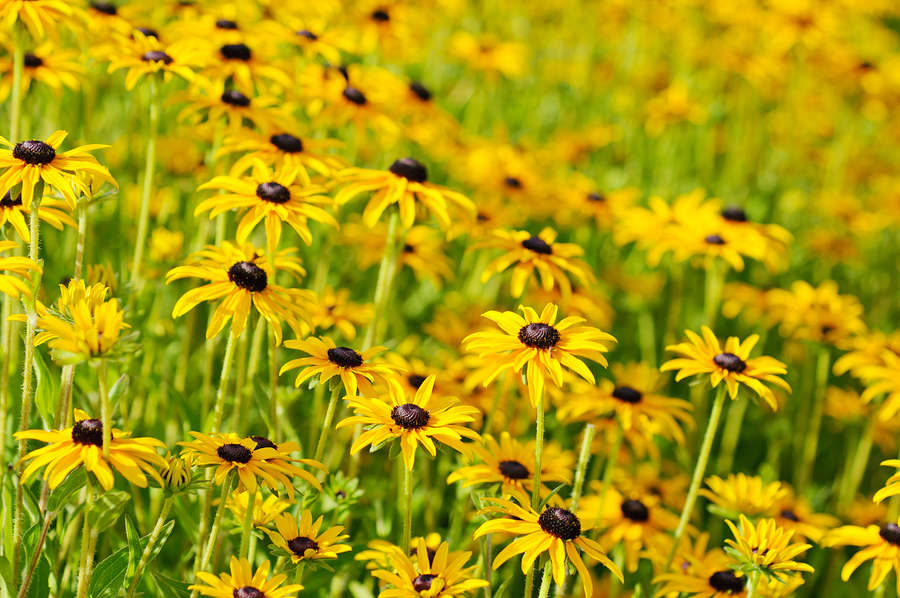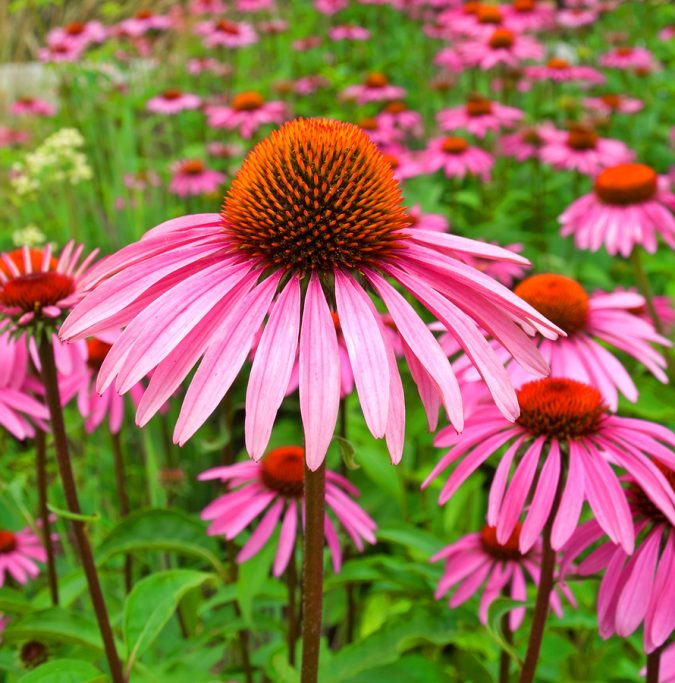
Echinacea
Echinacea has long been touted as an effective anti-inflammatory and immune stimulant and for good reason, for it is. Millions of echinacea capsules have been consumed by folks trying to ward off colds and flu’s. While echinacea is indeed effective for stimulating the body to fight viral infections, in my clinical experience, it is even more effective when facing a bacterial challenge. I have used echinacea on all sorts of abscesses, infected wounds and even cases of severe sepsis where the bacterial infection has actually entered the blood stream and become systemic throughout the body.
However, there is another side to echinacea, a side that has saved many of my patients from disfiguring wounds or death from rattlesnake and venomous spider bites. The same property also makes echinacea a wonderful choice for the repair of torn cartilages and ligaments or other joint injuries. That property is echinacea’s ability to inhibit hyaluronidase and to actually stimulate hyaluronic acid production.
I know, big words. Hang with me for a minute there’s nothing here that isn’t easily understood if we talk about it in regular English.
 Echinacea (see right) has long been touted as an effective anti-inflammatory and immune stimulant and for good reason, for it is. Millions of echinacea capsules have been consumed by folks trying to ward off colds and flu’s. While echinacea is indeed effective for stimulating the body to fight viral infections, in my clinical experience, it is even more effective when facing a bacterial challenge. I have used echinacea on all sorts of abscesses, infected wounds and even cases of severe sepsis where the bacterial infection has actually entered the blood stream and become systemic throughout the body.
Echinacea (see right) has long been touted as an effective anti-inflammatory and immune stimulant and for good reason, for it is. Millions of echinacea capsules have been consumed by folks trying to ward off colds and flu’s. While echinacea is indeed effective for stimulating the body to fight viral infections, in my clinical experience, it is even more effective when facing a bacterial challenge. I have used echinacea on all sorts of abscesses, infected wounds and even cases of severe sepsis where the bacterial infection has actually entered the blood stream and become systemic throughout the body.
However, there is another side to echinacea, a side that has saved many of my patients from disfiguring wounds or death from rattlesnake and venomous spider bites. The same property also makes echinacea a wonderful choice for the repair of torn cartilages and ligaments or other joint injuries. That property is echinacea’s ability to inhibit hyaluronidase and to actually stimulate hyaluronic acid production.
I know, big words. Hang with me for a minute there’s nothing here that isn’t easily understood if we talk about it in regular English.
Our bodies are made of individual cells. These cells are held together by a chemical called hyaluronic acid. So, if the cells are the bricks that your body is built of, hyaluronic acid is the mortar that holds them together. The venom of rattlesnakes (and their cousins) and hobo spiders contain an enzyme (hyaluronidase) that dissolves the hyaluronic acid that holds the cells together. The result is that when these animals bite, their venom actually liquefies tissue. This process causes terrible, disfiguring wounds and sometimes death. There are also several species of bacteria that produce this same enzyme. The wounds infected with such organisms can become gangrenous with massive tissue loss. Fortunately, echinacea is able to prevent and even repair the damage of this process. The prevention comes in the form of a chemical contained in echinacea that inhibits the destructive enzyme from doing its work in the first place. The repair is aided by echinacea’s ability to stimulate the body to produce more hyaluronic acid (the mortar between the bricks) so that it has more material available to effect repairs.
Echinacea’s ability to increase hyaluronic acid production also makes it a great herb for cases of ligament, cartilage or joint injury or even arthritis. When we think about arthritis we usually think about devil’s claw, white willow, yucca, frankincense, turmeric and the other usual suspects. These herbs all have anti-inflammatory properties that diminish pain and reduce swelling. Decreasing pain and swelling is great, but echinacea can take things one step further and actually help the body repair the damage.
Hyaluronic acid (the mortar between your bricks) is a major component in cartilage and synovial fluid (the fancy doctor word for joint juice). When joints are damaged either by injuries or by the inflammatory processes of arthritis, they need hyaluronic acid to effect repairs. Echinacea comes to the rescue by stimulating fibroblasts and chondroblasts (the cells that make cartilage) to make increased levels of hyaluronic acid…more mortar to hold the new bricks together so the body can re-build.
So echinacea is a terrific herb not only for stimulating the immune system, killing bacteria and reducing inflammation, but it also inhibits the destruction of tissue by flesh-eating bacteria, venomous snakes in the pit viper family (rattlesnake, copperhead and water moccasin) and hobo spiders. In addition, Echinacea can help heal damaged joints, ligaments and cartilage by stimulating production of exactly what damaged joints need to repair themselves. What could be bad?
I’ve also had great success treating hobo spider bites with echinacea. The bite of the hobo is very painful and often causes serious necrosis. The necrosis isn’t caused by hyaluronidase in the hobo’s case but rather by another mechanism. However the result is the same, a nasty disfiguring wound. I’ve had several occasions to treat hobo bites in humans and many presumed hobo bites in dogs (presumed because dogs will never tell me what the spider looked like). The results have been excellent.
My own daughter was bitten by a hobo. She developed a dime-sized lesion with a nasty line encircling it. A physician told her “I’m sorry sweetheart, but your going to slough half your palm and there’s nothing I can do about it.” She drove home from college the same day to see Daddy the herbalist. I developed a formula (see below) applied it as a poultice and poked it into her orally every two hours throughout the day as well. Within 12 hours the nasty ring was gone. In 24 hours we couldn’t discern where the bite was by looking.
I don’t know if the echinacea is neutralizing the venom somehow as it does with the snake bites or if the increased hylauronic acid production is helping. Could be that it’s another mechanism entirely. What I do know from clinical experience is that it works beautifully.
So, for chronic injuries, torn ligaments, sprains, tears and arthritis add a little echinacea to the mix. If you are bitten by a venomous snake or a hobo spider, get on some echinacea as well.
The formula I use for snake and spider bites is:
Echinacea
Plantain
Marshmallow
Dandelion root
Saw Palmetto
I mix them in equal parts. I make a poultice to put on topically by mixing them with water. This I change every few hours. I also give the formula orally at a rate of about a tablespoon every two hours for an adult human. Dogs get a teaspoon.
Remember too that echinacea is a mild herb. Take it often…every two hours or so for acute conditions, three times a day for chronic injuries.
If you don’t have access to echinacea and live in the Western United States, Rudbeckia hirta (Black-Eyed Susan) and Rudbeckia lanciata (Yellow Coneflower) are near cousins with similar medicinal properties. They grow wild throughout the West and probably in other parts of the country as well.

Rudbekia flowers (Black-eyed Susans)

Rudbeckia laciniata
Doc Jones
Marjory Wildcraft is an Expedition Leader and Bioneer Blogger with The [Grow] Network, which is an online community that recognizes the wisdom of “homegrown food on every table.” Marjory has been featured as an expert on sustainable living by National Geographic, she is a speaker at Mother Earth News fairs, and is a returning guest on Coast to Coast AM. She is an author of several books, but is best known for her “Grow Your Own Groceries” video series, which is used by more than 300,000 homesteaders, survivalists, universities, and missionary organizations around the world.








COMMENTS(4)
Excellent article!
oh wow thanks so much Doc Jones! We have used echinacea for years to chase away colds…love it…..but I knew it was great for poison bites but not how it works, and now I will take it for my poor inflamed joints! You are so generous and I am grateful!
Great article. But I’d really like to see it (and all of them) ‘printer friendly’!
What is your formula for chronic injuries, torn ligaments, sprains, tears and arthritis?